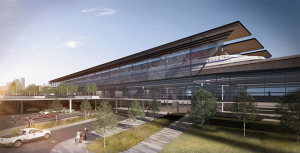 The U.S. Federal Railroad Administration (FRA) has released the final Rule of Particular Applicability (RPA) and the record of decision (ROD) for Texas Central Railroad marking a major achievement for the Texas high-speed rail project and bringing it closer to construction.
The U.S. Federal Railroad Administration (FRA) has released the final Rule of Particular Applicability (RPA) and the record of decision (ROD) for Texas Central Railroad marking a major achievement for the Texas high-speed rail project and bringing it closer to construction.
The RPA provides the regulatory framework for Texas Central Railroad, establishing a comprehensive set of safety requirements that will govern the signalling system of the new line, the rolling stock, the control, track, operating rules and practices, system qualifications, and maintenance. This RPA is based on a system approach to safety which incorporates accident avoidance measures that are significantly more stringent than those required for conventional U.S. rail operations.
The proposed railway system is based on the Japanese Tokaido Shinkansen high-speed rail system, as operated by the Central Japan Railway Company (JRC). Texas Central chose this system because of its reputation as being one of the safest and most punctual train systems in the world.
As noted by the FRA, “this regulation was written specifically for this technology to maintain the integrity of the baseline safety case” of JRC’s Tokaido Shinkansen and establishes “regulatory requirements codifying the service-proven technological, operational, and maintenance aspects of the Tokaido Shinkansen HSR system.”
The record of decision completes the FRA’s environmental review process that began in 2014 as required by the National Environmental Policy Act (NEPA) and culminated with the publication of the Final Environmental Impact Statement that was released in May 2020. The ROD also formally selects the alignment that Texas Central Railroad will follow between Dallas and Houston.
“This is the moment we have been working towards. The release of the final RPA and ROD by the Federal Railroad Administration represents years of work by countless individuals, affirming a very thorough and careful federal regulatory process that will make the Texas Central Railroad the first high-speed rail system to be implemented in the United States,” Carlos Aguilar, CEO of Texas Central Railroad said.
The Texas high-speed rail project involves the construction of a 386 km-long dedicated corridor between Houston and Dallas/Fort Worth with three stations in Dallas, Houston and a stop in the Brazos Valley. Able to run at speeds of more than 320 km/h, the trains will cover the distance within 90 minutes with departures every 30 minutes during peak periods each day.
Last year, a design-build contract was signed with Webuild consortium comprising Salini Impregilo and Lane Construction Corp.
Bechtel will oversee all aspects of the project as well as the integration of all scopes, and Mass Electric Construction, a subsidiary of Kiewit, will be responsible for rail systems’ construction and installation.
Renfe was awarded a USD 6 billion contract to operate the railway system.
Share on:



